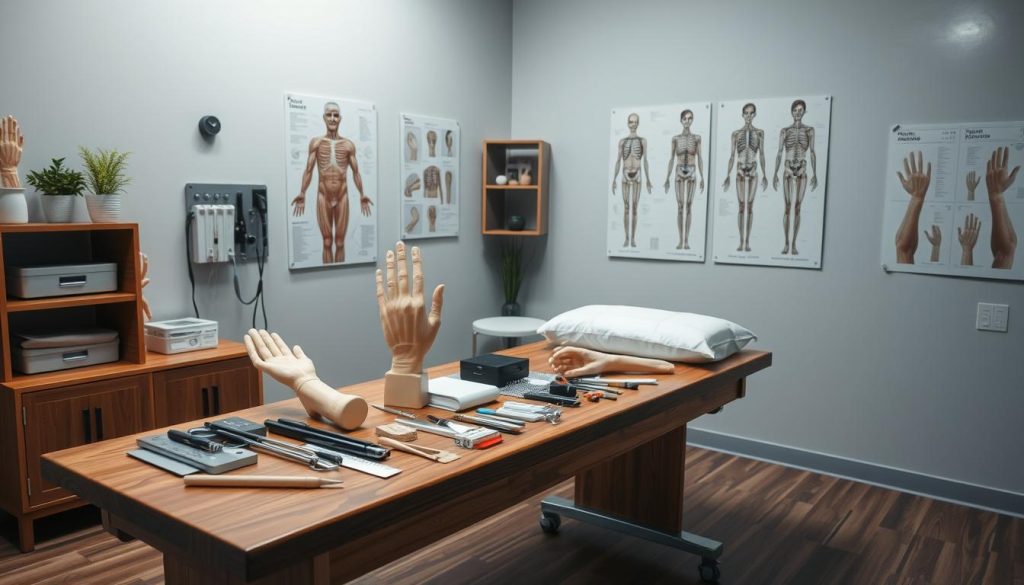CHT (Certified Hand Therapist) Test: Your Guide
As a healthcare professional, you know how key specialization and certification are. The CHT (Certified Hand Therapist) test is a top credential. It shows you’re an expert in upper extremity rehab. This guide will help you understand the CHT exam well. It will give you the tools to do great in this field.

Key Takeaways
- The CHT (Certified Hand Therapist) test is a crucial credential for hand therapy specialists in the United States.
- Earning the CHT certification showcases your mastery of upper extremity rehabilitation and hand therapy principles.
- Comprehensive preparation strategies are essential for successfully passing the CHT exam.
- Understanding the certification process and eligibility requirements is the first step towards attaining this prestigious credential.
- Passing the CHT test can open doors to rewarding career opportunities in the field of hand therapy and rehabilitation.
Unlock Your Potential: Mastering the CHT (Certified Hand Therapist) Test
Becoming a Certified Hand Therapist (CHT) is a big achievement. It opens doors to advanced hand therapy. To get this certification, you need to go through a detailed process. This includes both learning and practical work. We’ll cover the steps and what you need to start your journey to becoming a CHT.
Understanding the Certification Process
The CHT certification tests your skills in upper limb rehabilitation. The Hand Therapy Certification Commission (HTCC) gives the exam. It covers anatomy, physiology, biomechanics, and treating wrist and hand injuries. You need to know these well to pass.
Eligibility Requirements and Prerequisites
To take the CHT exam, you must meet certain rules. These include:
- A licensed occupational therapist (OT) or physical therapist (PT) with at least 4,000 hours of hand therapy experience in 3 years.
- Finishing a post-professional graduate-level certificate in advanced practice hand therapy, or 80 hours of hand therapy education in 5 years.
- Showing you’re good at hand therapy by a certified hand therapist (CHT).
Meeting the certified hand therapist requirements and getting ready for the CHT exam is tough. But, knowing the process and making a good study plan can help. This way, you can reach your goal of becoming a CHT.
| Eligibility Criteria | Requirement |
|---|---|
| Licensed Occupation or Physical Therapist | Yes |
| Minimum Clinical Experience in Hand Therapy | 4,000 hours over at least 3 years |
| Advanced Practice Hand Therapy Education | Graduate-level certificate program or 80 hours of continuing education within 5 years |
| Verification of Clinical Competence | By a qualified Certified Hand Therapist (CHT) |
By knowing how to prepare for the cht exam and meeting the upper limb rehabilitation certification needs, you’re on the right path. You’ll show your skills in hand therapy and get the respected CHT credential.

Comprehensive Exam Preparation Strategies
Getting ready for the Certified Hand Therapist (CHT) exam needs a solid plan. As you aim to become a hand therapist, make a detailed study plan. Focus on the areas the test covers. Using the right study methods can boost your chances of passing.
We’ve put together some useful tips to help you prepare:
- Develop a Structured Study Plan: Make a study schedule that covers all subjects. Spend more time on areas you’re not good at. This will help you understand hand therapy techniques and hand therapy modalities better.
- Familiarize Yourself with the Exam Format: Learn about the CHT exam’s structure and content. Know the types of questions, how much time you have for each section, and how it’s scored.
- Engage in Comprehensive Review: Go through the certified hand therapist training curriculum. This includes occupational therapy for hands and physical therapy for hands. Use books, online courses, and practice exams to review.
- Practice, Practice, Practice: Take practice exams and sample questions often. This helps you get used to the exam format and timing. It also shows you where you need to improve.
- Collaborate with Peers: Join study groups with other hand therapy students. Discuss topics, share knowledge, and learn together.
- Seek Guidance from Experts: Talk to experienced certified hand therapists or occupational therapists. They can offer advice and help with your preparation.
By using these strategies, you’ll be ready for the Certified Hand Therapist exam. Remember, hard work and a clear plan are essential to succeed in hand therapy.
| Exam Preparation Strategies | Benefits |
|---|---|
| Develop a Structured Study Plan | Ensures efficient time management and targeted learning |
| Familiarize Yourself with the Exam Format | Helps you navigate the test with confidence and reduce anxiety |
| Engage in Comprehensive Review | Enhances your understanding of key hand therapy techniques and hand therapy modalities |
| Practice, Practice, Practice | Improves your test-taking skills and identifies areas for improvement |
| Collaborate with Peers | Fosters a supportive learning environment and shared knowledge |
| Seek Guidance from Experts | Provides valuable insights and advice from experienced certified hand therapists |

Conclusion
This guide has shown us the importance of the Certified Hand Therapist (CHT) credential. It’s a key step for those in hand therapy wanting to grow. By passing the CHT exam, you prove your skill in upper extremity rehabilitation. You also open doors to new chances in occupational therapy.
The CHT certification teaches you how to handle tendon injuries and use splinting techniques well. It prepares you to care for patients with arthritis and nerve compression disorders. With it, you can give personalized care that improves your clients’ lives.
Getting the CHT credential shows you’re an expert in upper extremity biomechanics. It also leads to more career chances. As a Certified Hand Therapist, you’ll help shape hand therapy’s future. You’ll make a big difference in people’s lives.